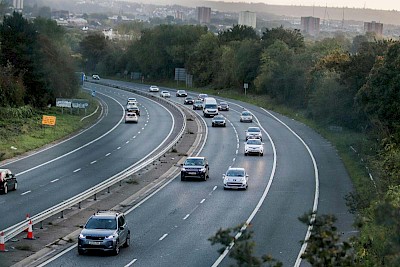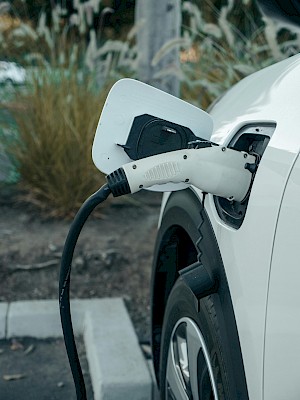The maintenance and expansion of Britain’s road network requires a staggering amount of ongoing investment with areas of focus largely determined by the road investment strategy (RIS) set out by the Government. As the period covering RIS2, the second Government road investment strategy, approaches its end with an Interim Settlement for National Highways set to begin on 1 April this year, we review what the likely shape of RIS3 will be and what the key issues being tackled by the sector are likely to mean for us and our merchant partners over the next five years.
The size of the highways sector and the potential investment in Britain’s road networks presents a significant opportunity for the construction sector, construction product manufacturers and our merchant partners. Excluding repairs and other works on existing road networks, National Highways (formerly The Highways Agency) has set aside £347 million for over 30 potential new road schemesi during the period 2025 to 2030 alone. It will also invest a total of £936-million in the UK’s road network between 2020 and 2025ii.
And National Highways only covers England, and only motorways and major A-roads, what the Government refers to as the ‘Strategic Road Network’ or SRN. Incredibly, this accounts for just 3% of Britain’s road network. The rest of the UK’s road network is managed by local authorities, which look after local roads; Transport Scotland and the Welsh Government which manage roads in Scotland and Wales respectively, and Transport for London which looks after roads in our capital cityiii.
RIS2iv - the second road investment strategy to set out Government plans for developing and improving the SRN – comes to an end in March with an ‘Interim Settlement for National Highways’ created to cover the period April 2025 to the end of March 2026 when RIS3 will be implemented.
While Government priorities and spend are being finalised for RIS3, the highways sector will continue to focus on the delivery of mega-schemes which were included within RIS2 but which have yet to be completed. The National Audit Office estimates that around £15bn of RIS2 projects are in fact still to be delivered.
RIS3 also confirms that any enhancement schemes “which had funding approved in an earlier RIS, whose development has shown that they remain deliverable and value for money, and where construction has not concluded by 31 March 2025 will continue to be funded in RIS3.”v So, although exact capital expenditure figures are to be confirmed for RIS3, it looks likely that demand for drainage, ducting and storm water management systems for these mega projects will continue for some years to come.
The highways sector will also, of course, be required to deliver the requirements of RIS3 during the period 2025 to 2031, requirements which currently look notably different from those included in RIS2.
While RIS2 focussed primarily on large road schemes which, according to the Transport Action Network, spent more than half of its budgetvi, RIS3 will instead focus on the development and maintenance of smaller road networks which support local communitiesvii, something which the Second National Infrastructure Assessment identified as “crucial to the goal of levelling up economic opportunities in all parts of the country and improving the quality of life.” viii
 Following the recommendations of The National Infrastructure Commission, the Government’s RIS3 strategy will also look at three other areas which are likely to drive the specification of additional drainage, ducting and storm water management systems: a requirement for improved environmental outcomes especially when it comes to controlling pollution from highway surface water run-off and flooding; a requirement to drive the decarbonisation of the UK’s transport systems and specifically, to expand the electric vehicle (EV) charging network, and a requirement to reduce carbon emissions.
Following the recommendations of The National Infrastructure Commission, the Government’s RIS3 strategy will also look at three other areas which are likely to drive the specification of additional drainage, ducting and storm water management systems: a requirement for improved environmental outcomes especially when it comes to controlling pollution from highway surface water run-off and flooding; a requirement to drive the decarbonisation of the UK’s transport systems and specifically, to expand the electric vehicle (EV) charging network, and a requirement to reduce carbon emissions.
The need to control pollution contained within surface water run-off whether that’s coming off new or existing roads is an important and increasingly topical issue being faced by the highways sector. Indeed, pollution caused by surface water run-off from the UK’s road network is a major concern.
The Environment Agency says that “highways drainage and urban diffuse pollution is a serious issue causing 18 percent of failures for water bodies in England under the Water Framework Directive”ix. While UNESCO backed research undertaken by the University of Brightonx states that "Road drainage is the third highest cause of water pollution in the UK.”
Currently, water in road drainage is either channelled into the sewage system or left to soak into the ground. It often carries metals and hydrocarbons as well as particles from vehicle tyres which ultimately effect the surrounding natural environment and risk polluting aquifers – layers of rock that can hold and release water – that supply water to many urban areas.
Just over 12 months ago, The Guardian newspaper reported that more than 18,000 outfalls and more than 7,000 soakaways discharge rainwater which potentially contains heavy metals, hydrocarbons, microplastics and other chemicals into rivers and surrounding land . National Highways itself reports that more than 1200 of these outlets and soakaways “had a potential high risk for pollution”.
National Highways, Transport Scotland, the Welsh Government and local authorities are responsible for regulating and minimising this type of pollution, a task that cannot be underestimated.
Clearly it’s not practical to retrofit every highways drainage system in the UK but it is possible to specify a solution which prevents harmful pollutants contaminating the water supply, something which will become increasing important under RIS3 which currently focuses on the maintenance as well as creation of road networks. Naylor’s ‘SmartSponge’, for example, removes and holds polluting hydrocarbons and oil derivatives contained within surface water run-off but can easily be fitted into an existing road network.
As we continue to experience increasing amounts of rainfall and more frequent high intensity rainfall events, mitigating the risk of flooding is also a priority. The design and specification of drainage systems which can deal with higher volumes of water is critical for new road schemes but products which are able to deal with stormwater are of increasing value to the highways sector as it seeks to update our existing highways infrastructure. Manufactured from recycled polypropylene Naylor’s AquaVoid system, for example, is designed to deal with stormwater at or near to its source in service station areas and car park applications.
While RIS3 and Government targets driving the switch to electric vehicles (EVs) also mean that the need for an extended EV charging infrastructure is already driving demand for high performance ducting solutions. In response to this, Naylor has recently launched a range of uPVC Class 1 and Class 2 ducts which are manufacturing in accordance with ENATS 12-24 and are suitable for use in high voltage applications including EV infrastructure networks.
 Last but by no means least, RIS3 underlines that there is a pressing need to ensure that the construction and maintenance of Britain’s road network is undertaken with the lowest possible impact on the environment. This is very unlikely to change. RIS3 states: “The future of road travel is a decarbonised one, with vehicles powered by electricity, hydrogen and biofuels, running on infrastructure that has been built, maintained and operated using near zero carbon products, techniques and practices.”xi
Last but by no means least, RIS3 underlines that there is a pressing need to ensure that the construction and maintenance of Britain’s road network is undertaken with the lowest possible impact on the environment. This is very unlikely to change. RIS3 states: “The future of road travel is a decarbonised one, with vehicles powered by electricity, hydrogen and biofuels, running on infrastructure that has been built, maintained and operated using near zero carbon products, techniques and practices.”xi
The focus on the use of ‘near net zero carbon products’ means that construction products manufacturers have an increased requirement to develop low carbon alternatives to current products if they are to meet the needs of the highways sector. Products such as MetroDrain LC, the lower carbon version of Naylor’s popular MetroDrain system which is ranked number one by National Highways, will have a key role to play as manufacturers and their merchant partners seek to support the sector as it strives to deliver RIS3.
In summary, the highways sector has some significant challenges to address during the next five years including the delivery of mega-projects originally included in RIS2, the change of emphasis to focus more on local road networks, supporting the country’s move to more sustainable forms of transport, dealing with and mitigating risks presented by climate change, and its role in the delivery of a reduced, if not net, zero economy.
Your role, whether you’re a construction products manufacturer like Naylor or one of its merchant partners, is to ensure we are able to develop and supply the solutions the highways sector needs to meet these challenges and to deliver the highways infrastructure which is essential for all of us in our everyday lives.
References:
i https://nationalhighways.co.uk/our-roads/pipeline-of-possible-future-schemes/
ii https://nationalhighways.co.uk/our-work/designated-funds/
iii https://www.gov.uk/government/organisations/highwaysengland/about#:~:text=Highways%20England%20is%20the%20government,by%20the%20relevant%20local%20authority
iv https://assets.publishing.service.gov.uk/media/5ec4ee1686650c278d449775/ris2-analysis-overview.pdf
v Page 5 - https://assets.publishing.service.gov.uk/media/61decac1e90e07037668e1eb/planning-ahead-for-the-strategic-road-network-developing-the-third-road-investment-strategy.pdf
vi https://transportactionnetwork.org.uk/tan-advance-press-notice-on-draft-road-investment-strategy-3-publication/
vii https://assets.publishing.service.gov.uk/media/61decac1e90e07037668e1eb/planning-ahead-for-the-strategic-road-network-developing-the-third-road-investment-strategy.pdf - page 8
viii https://nic.org.uk/themes/transport/#tab-summary
ix https://deframedia.blog.gov.uk/2023/10/06/guardian-article-on-road-runoff/
x https://www.brighton.ac.uk/news/2022/unesco-backs-brighton-project-to-tackle-pollution-from-road-drainage
xi Page 7 - https://assets.publishing.service.gov.uk/media/61decac1e90e07037668e1eb/planning-ahead-for-the-strategic-road-network-developing-the-third-road-investment-strategy.pdf
